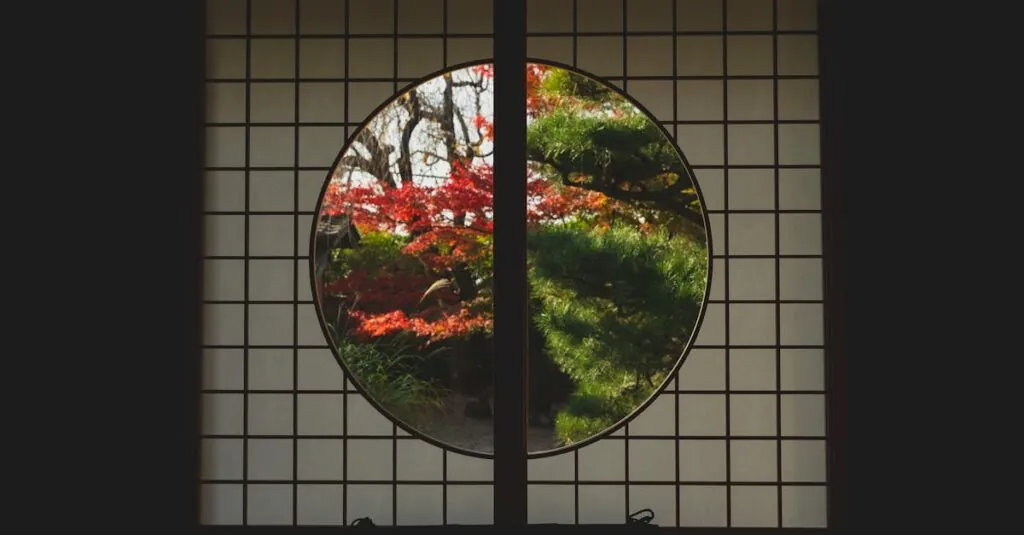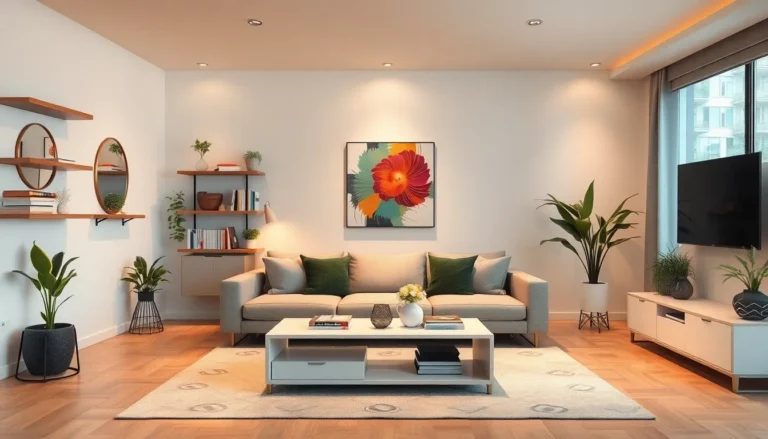Japanese style interior design isn’t just a trend; it’s a lifestyle that whispers tranquility and invites serenity into any space. Imagine stepping into a room where simplicity reigns supreme, and every element serves a purpose. From tatami mats to shoji screens, this design philosophy harmonizes nature and minimalism in a way that makes even the most cluttered minds feel at peace.
Table of Contents
ToggleOverview of Japanese Style Interior Design
Japanese style interior design embodies a lifestyle centered on tranquility and simplicity. Emphasis lies on minimalism, with purposeful design elements creating a serene atmosphere. Characteristics include tatami mats and shoji screens, which serve both functional and aesthetic purposes. Natural materials like wood and stone enhance the connection to nature and promote warmth.
Incorporation of greenery plays a vital role, with plants providing life and vibrancy to spaces. Light is another essential element, with open layouts and ample natural light enhancing the feeling of spaciousness. Colors in Japanese design often remain neutral, featuring tones like beige, gray, and soft pastels that evoke a sense of calm.
Furniture in Japanese interiors tends to be low to the ground. This design choice complements the use of tatami mats and encourages a more intimate setting. Less clutter proves crucial, as each piece serves a specific function without overcrowding the space.
Cultural influences from Zen philosophy reflect in various design aspects, promoting a balanced lifestyle. Art often showcases nature-inspired themes, reinforcing harmony and tranquility throughout the home. Functional items blend seamlessly with aesthetic pieces, illustrating the philosophy of beauty in simplicity.
Overall, Japanese style interior design not only transforms spaces but also nurtures a lifestyle that prioritizes peace and mindfulness. Adopting this design approach fosters an environment conducive to relaxation and reflection.
Key Elements of Japanese Style Interior Design
Japanese style interior design emphasizes specific characteristics that create a harmonious living environment. Key elements include minimalism, natural materials, and a strong connection to the outdoors.
Minimalism and Simplicity
Minimalism defines Japanese interior design. Spaces prioritize functionality while eliminating excess. Simple lines and clean shapes dominate furniture and decor. Less clutter enhances tranquility, allowing for mindful living. Purposeful placement of each item contributes to the overall balance. Open layouts foster freedom and facilitate movement. Additionally, neutral colors convey warmth and serenity, anchoring the aesthetic.
Natural Materials
Natural materials play a vital role in Japanese style. Wood, bamboo, and stone evoke a sense of connection with nature. Availability of these materials encourages sustainability in design choices. Textured surfaces add warmth, creating inviting spaces. Tatami mats serve as traditional flooring, featuring rice straw and woven rush, enhancing comfort. Incorporating raw elements showcases craftsmanship and appreciation for the environment. Artifacts crafted from natural materials often reflect cultural heritage and promote a calm ambiance.
Indoor-Outdoor Connection
Creating an indoor-outdoor connection enhances harmony in Japanese homes. Large windows allow natural light to flood interiors while inviting outside views. Courtyards, gardens, and sliding shoji screens blur lines between inside and outside spaces. Greenery adds life and color, boosting overall aesthetics. Direct interaction with nature promotes well-being and tranquility. Each design choice encourages appreciation for changing seasons, nurturing mindfulness and reflection.
Popular Features in Japanese Style Interior Design
Japanese style interior design focuses on a few key features that create a harmonious atmosphere. Notable elements reflect a deep connection to nature and simplicity.
Shoji Screens
Shoji screens serve dual purposes in Japanese homes. These sliding panels, made from a wooden frame and translucent paper, allow natural light to filter through while providing privacy. Often used to separate spaces, shoji screens contribute to the overall openness and tranquility of a room. Their delicate design embodies a minimalistic aesthetic, seamlessly blending with other elements while inviting a sense of calm.
Tatami Mats
Tatami mats represent traditional Japanese flooring that enhances comfort and warmth. Crafted from rice straw and covered with woven grass, these mats offer a unique texture underfoot. Often found in living rooms and bedrooms, tatami mats promote a connection with nature and sustainability. The soft and natural qualities of tatami mats foster a serene environment, encouraging relaxation and mindfulness within the space.
Fusuma Doors
Fusuma doors add versatility to interior layouts by serving as sliding partitions. These papered doors encapsulate artistic designs, often reflecting nature motifs. Positioned between rooms, fusuma doors allow for easy reconfiguration of space, promoting flexibility in everyday living. Their stylish design enhances the aesthetic appeal while maintaining a minimalist approach, making them a significant feature in Japanese interior design.
Color Palettes in Japanese Style Interior Design
Color palettes in Japanese style interior design embrace simplicity and serenity. These designs utilize a combination of neutral tones and intentional accent colors to create harmonious environments.
Neutral Tones
Neutral tones dominate Japanese interiors, promoting calm and balance. Shades of beige, cream, and soft gray provide a serene backdrop that enhances natural light. These colors reflect tranquility and serve as a canvas for furniture and decor. Incorporating earthy hues, such as olive green or taupe, further connects spaces to nature. Minimal color distractions maintain focus, allowing the beauty of the materials and craftsmanship to shine. This emphasis on understated colors creates a cohesive look and promotes a peaceful atmosphere suited for mindfulness.
Accent Colors
Accent colors play a crucial role in adding vibrancy to Japanese interiors. Rich blues, deep greens, and warm reds often appear sparingly, showcasing nature-inspired themes. Small decorative elements, such as cushions or artwork, highlight these colors and create focal points without overwhelming the space. For example, a bright floral pattern on a throw pillow adds a pop of life against neutral backgrounds. Thoughtfully chosen accent tones enhance visual interest while aligning with the overall minimalist aesthetic. This strategic approach ensures that color enhances rather than dominates, contributing to a harmonious environment.
Benefits of Japanese Style Interior Design
Japanese style interior design offers numerous benefits that contribute to a tranquil living environment. First, simplicity promotes a serene atmosphere, allowing individuals to focus on what truly matters. Minimalistic decor emphasizes essential functions, creating uncluttered spaces. Furthermore, the incorporation of natural materials fosters warmth and a deeper connection to nature.
Comfort increases with features like tatami mats, which enhance the sense of relaxation and well-being. The use of wood, bamboo, and stone reinforces sustainability while adding aesthetic appeal. Large windows invite sunlight into the home, encouraging an indoor-outdoor connection that nurtures peace and mindfulness.
Another advantage lies in the neutral color palettes, which create a calming backdrop and minimize distractions. Earthy tones contribute to a grounded feel, connecting interiors to the natural world. Limited use of accent colors, like rich blues or warm reds, adds vibrancy without overwhelming the design ethos.
Fostering functionality, furniture in Japanese interiors often features low profiles that facilitate a sense of openness. This encourages movement throughout the space, promoting a free-flowing atmosphere. Shoji screens and fusuma doors provide adaptable layouts, allowing residents to alter their environments based on their needs while maintaining a harmonious aesthetic.
Finally, embracing Zen philosophy guides the overall approach, emphasizing balance and mindfulness in daily life. Incorporating art that reflects nature enhances this sense of connectedness, creating an environment where individuals can truly thrive. The numerous benefits of Japanese style interior design collectively create a sanctuary that prioritizes tranquility and mindfulness.
Japanese style interior design offers a unique approach to creating serene and tranquil spaces. By embracing minimalism and natural elements it fosters a sense of peace that resonates deeply with those seeking a calming environment. The thoughtful incorporation of materials like wood and stone enhances warmth while maintaining a connection to nature.
This design philosophy encourages mindfulness and balance through its clean lines and purposeful layouts. With features such as shoji screens and tatami mats, it not only enhances aesthetics but also promotes well-being. Adopting this style can transform any space into a sanctuary that prioritizes tranquility and reflection, making it a valuable choice for modern living.








